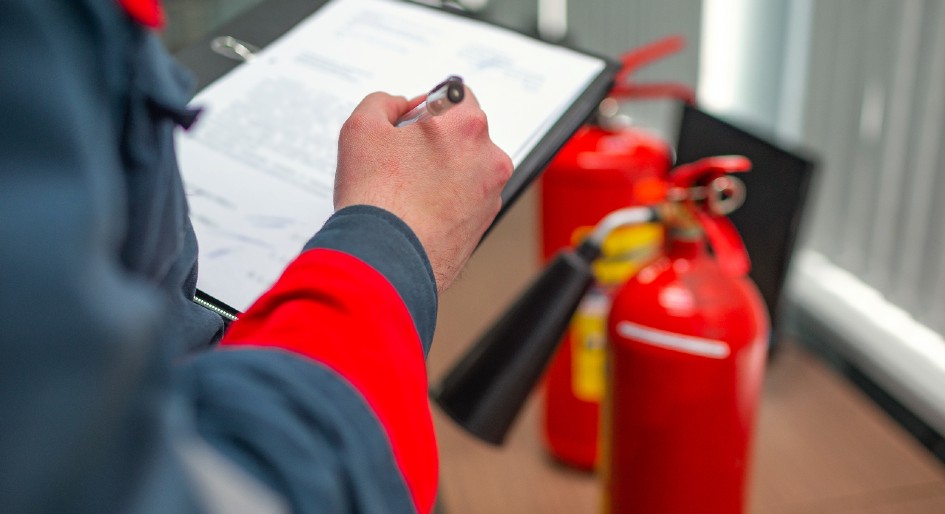Extensive safeguards are required to protect workers, occupants and facilities from fire-related events. The larger, more complex, and higher-risk the facility, the more safeguards and fire protection equipment are required.
Fire protection consists of a plentiful list of items to prevent and minimize damage, and is divided into two categories: fire equipment and fire emergency systems. Fire equipment is the main tool at the disposal of workers, occupants and emergency response personnel in the event of a fire; while fire emergency systems are built-in lines of defence that are designed and engineered to prevent a fire from spreading, alert occupants and allow for quick escape.
Compliance Culprits
With fire equipment, the biggest culprit for non-compliance issues usually involves obstructions blocking fire extinguishers and hoses from view.
If inspectors are making their rounds without measures in place to prevent items from being missed, it’s not hard to imagine them accidentally overlooking a blocked fire hose cabinet. After all, fire extinguishers are often cited as the most frequently missed inspection item by industry professionals.
For fire emergency systems, the potential for inspection issues increases dramatically with building size and complexity. In high-rise buildings, for example, elevators must be operated by a firefighter using a keyed-switch (particularly the designated firefighter elevator), routes of egress and means of ventilation must be unobstructed, and alarm systems and emergency power must be operational.
Fire-rated doors, or fire doors, are an integral part of fire emergency systems that provide passive fire protection and help contain and compartmentalize a fire, along with providing a path of egress for occupants.
The door, frame, hinges, hardware, glazing, glass kit and glass beads must all be intact, secured and in good working order with no missing parts. Signage must be present and affixed securely, and labels must be clearly visible and easy to read with no modifications. The key for fire doors is to remain unobstructed, as this is a major cause of non-compliance and threat to occupant safety.
Sprinkler valves are another fire emergency system to keep your eye on. The valves should be checked for signs of physical damage or leaks, water pressure from the valves must be sufficient to extinguish a fire, and the valves must remain unobstructed.
Pro tip: during construction, valves may be shut off for work to be conducted. When valves are off, extra checks must be performed to maintain safeguards especially if hot work is performed.
Having a sound Fire Watch program is imperative to protecting your facility and liability.
Facility managers and their teams must effectively oversee so many different elements of fire protection, which is why it’s crucial to develop and implement effective procedures to ensure compliance and emergency preparedness.
Digitizing Inspections
One effective solution to reduce risk is digitizing fire protection inspections. Leaving the logbooks behind for a digital solution that leverages technology such as near-field communication will ensure that each piece of equipment was visited (reducing false-reporting) and will streamline the rest of the inspection process for the facility’s team. An integrated system that can alert of near-due, overdue and deficient inspection items is an easy way to help ensure compliance.
Take fire equipment, for example. If a facility has 100 fire hose cabinets (FHC), a digital solution will help keep track of the inspection status for each FHC, including remaining inspections; this will ensure the facility’s team stays informed through automated email notifications with daily, weekly and/or monthly summaries outlining if any FHCs were missed or have deficiencies and will remove the need to review inspection paperwork.
Digital solutions are also beneficial for inspectors because it will alert them if they have any remaining inspections. It makes the inspecting process seamless by allowing inspectors to include photos and notes, look up manufacturing information, upcoming service dates, and instructions and information specific to the equipment they’re inspecting.
The same goes for fire doors, sprinkler valves and other fire emergency system inspections. Dynamic questions, fields and instructions can be customized according to individual components and inspection needs for each item—for example, if a sprinkler valve is in the open position and the valve pressure is within the operable range.
Digitizing inspections makes compliance effortless with access to facility data in an exportable and packaged format that is secure, easily accessible and meets code retention requirements. Inspection data can be collected to generate powerful analytics and trends to forecast future inspection needs and associated costs, and review team performance.
At a certain point, it makes far less sense to stick with the same old pen and paper or electronic forms for routine fire protection inspections, and the pandemic has shown us that technology is integral to thriving in uncertain times.
Paul Amendola is chief executive officer of Tap Report, a Toronto-based firm that specializes in creating safer workplaces through software.







